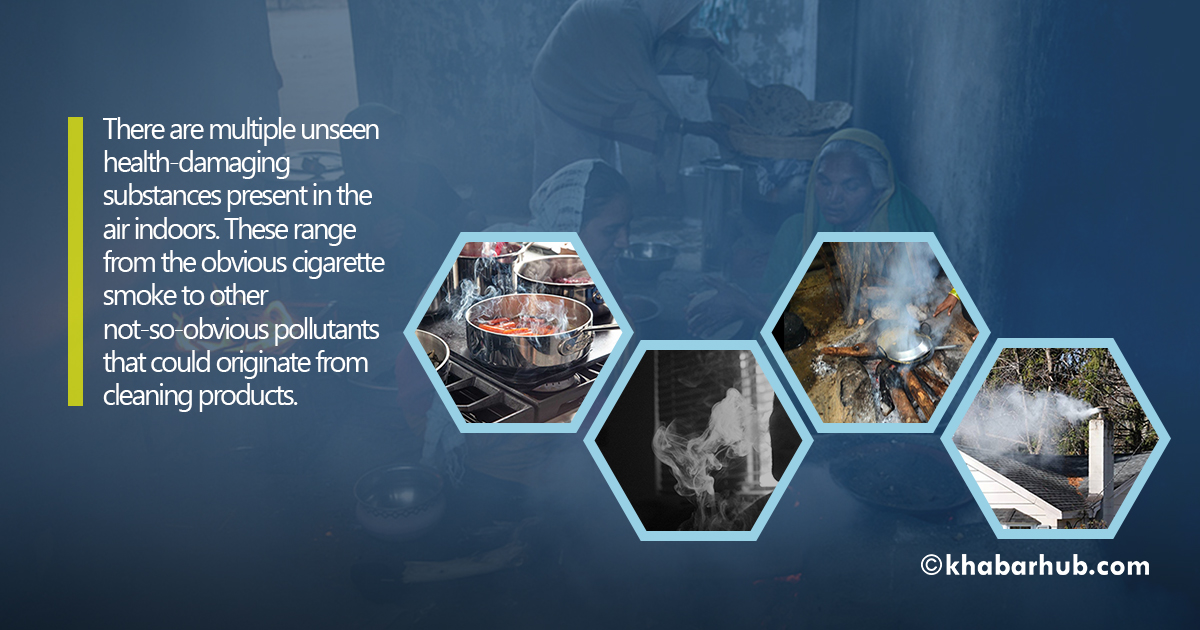KATHMANDU: When public outrage related to air pollution is directed towards the government, it’s high time that the people asked themselves what substantive and impactful measures they have adopted to mitigate the environmental hazards.
The public grudges and relentless media coverage on environmental issues have been a common phenomenon. However, not much effort — both from the government and the public — has been made to address these concerns notwithstanding its environmental risk factor.
“The emission caused by the increased number of vehicles, delays in fixing potholes, road widening spree, among others have been some common causes of air pollution virtually turning Kathmandu Valley into a dust bowl. At least we can escape from all that pollution at home, right? Actually, as things stand, not really. ”
As discussed in the previous article on Khabarhub, vehicular emissions and re-suspended dust have been the major polluters. Pollutants from these two sources account for more than half of the pollution that we face in our ambient air. That, however, is not all. The air in our homes could be as polluted as that of the outside.
World Health Organization (WHO) mentions household air pollution as one of the leading causes of disease and premature death in the developing world. Estimates indicate that it leads to around four million deaths every year – a figure that exceeds the death toll attributed to malaria, tuberculosis and HIV/AIDS combined.
Health experts remark that non-communicable diseases including stroke, ischemic heart disease, chronic obstructive pulmonary disease (COPD) and lung cancer are some of the consequences of indoor pollution.
Globally, 3.8 million people a year die prematurely from illness attributable to household air pollution. Particulate Matter (PM) and other pollutants in indoor smoke inflame the airways and lungs, impairing immune response and reducing the oxygen-carrying capacity of the blood.
Naturally, due to the prominence of outdoor air pollution, something as lethal as household pollution has gone unnoticed. For this reason, it is also sometimes called “A silent killer”. We spend up to 90 percent of our time indoors where the levels of some pollutants are higher than outside, often without proper ventilation.
There are multiple unseen health-damaging substances present in the air indoors. These range from the obvious cigarette smoke to other not-so-obvious pollutants that could originate from cleaning products. Some cleaning products release dangerous chemicals, including volatile organic compounds (VOCs).
Ammonia and bleach, which are common in cleaning products, are harmful as well. Even something as seemingly harmless as your perfume and air fresheners could contain VOCs that react with sunlight and other chemicals in the atmosphere to form ozone pollution.
Globally, around 3 billion people use solid fuels (like wood, charcoal, coal, dung, crop wastes) and kerosene in open fires and inefficient stoves for the purposes of cooking and heating.
National Census 2011 revealed that nearly 2 million out of 5.4 million households in Nepal were still using traditional biomass energy for cooking. The pollutants released from the burning of open fires include fine particulate matter (PM2.5) or small particles (PM10), ozone (O3), oxides of nitrogen (NOx), carbon monoxide (CO), polyaromatic hydrocarbons (PAHs) and sulphur-dioxide (SO2).
Fine particles are an especially strong indicator of health risks, as they can penetrate deep into the lungs, enter the bloodstream, and travel to organs.
The government is aiming to make all households in Nepal free of indoor air pollution by 2022. The biggest problem is that 77 percent of the country’s energy comes from traditional biomass energy. Considering how heavily we rely on biomass energy and fossil fuels, the target not only seems daunting but almost unrealistic.
A study conducted by Nepal Health Research Council in 2016 in 600 households in Ilam, the country’s far-eastern district, found that indoor pollution affects children the most. Infants and young children have a higher resting metabolic rate and a higher rate of oxygen consumption per unit body than adults.
This, paired with their narrower airways weakens their lungs and reduces immunity, leaving them more vulnerable to diseases. Indoor air pollution also impacts the development of children’s endocrine glands, their nervous system and the immune system.
Also Read, Cleaner air for Nepal: A collective effort
According to WHO, “Close to half of deaths due to pneumonia among children under 5 years of age are caused by particulate matter (soot) inhaled from household air pollution.”
Women, too, are disproportionately affected by indoor air pollution. This is due to the fact that it is mostly women that do the cooking, especially in rural regions of developing nations like Nepal, where they use polluting fuels and stoves.
As discussed above, this is one of the most polluting factors when it comes to pollution indoors. Women are twice as likely to suffer from COPD.
According to the Sustainable Development Goals (SDG) program by United Nations, the global share of the population with access to clean cooking fuels and technologies reached 61 percent in 2017, up from 57 percent in 2010. “Despite this progress, close to 3 billion people still rely primarily on inefficient and polluting cooking systems,” it said.
Polluting household fuels also endanger the health of the planet. Emissions of black carbon and methane from low-efficiency stoves also contribute to air pollution and increase the rate of climate change. Household burning contributes to 25 percent of global black carbon emissions.
UN’s SDG has set a target to ensure universal access to affordable, reliable and modern energy services by 2030.
Reasoning from these facts, there are easy practices that every one of us can implement in our day-to-day lives to improve indoor air quality. One very simple thing that just about everyone can and should do is improving ventilation at home to allow the flow of air.
Cigarette smokers should be encouraged to not smoke indoors. While it may seem like I am just stating the obvious here, it is important to remember that many people do not mind smoking indoors.
Another big step to cleaner air would be the use of clean cooking methods. Biogas, liquefied petroleum gas, electricity and natural gas are known as BLEN fuels. These are the cleanest solutions available that are able to reduce emission levels to match WHO guidelines for health.
Moreover, clean cooking can be a major help when it comes to the battle against global climate change. According to Clean Cooking Alliance, the second-largest contributor to climate change after carbon dioxide is black carbon emissions when it comes to cleaning opt for eco-friendly cleaning products.
This may not seems as easy, but just try to avoid known toxic ingredients such as ammonia, chlorine bleach, phosphates, and petroleum solvents.
Avoid products with labels that contain the words “hazardous”, “corrosive”, “irritant” or “inflammable” as these products generally contain pollutants. Choose products that do not contain or have reduced amounts of VOCs, fragrances, irritants and flammable ingredients.
Moreover, it is also possible to use do-it-yourself (DIY) methods to make your own cleaning products. As a safer cleaning alternative, warm water and soap often will do the trick, especially at home. Baking soda is good for scrubbing. A mix of vinegar and water can clean glass.
Maintaining control over the indoor humidity levels could be helpful in avoiding molding and rusting. Microbial pollution is a key element of indoor air pollution. It is caused by hundreds of species of bacteria and fungi, in particular, filamentous fungi (mold), growing indoors when sufficient moisture is available.
These days, commercial air purifiers are also available on the market. If you can afford to own one, air purifiers can be helpful to remove harmful particles and improve your air quality. However, remember that an air purifier is merely one step in the right direction.
In light of all of this information, when it comes to improving our air quality, especially at home, it is entirely up to us. Therefore, you cannot justify inaction by blaming it on the government. So let’s act, now!









Comment